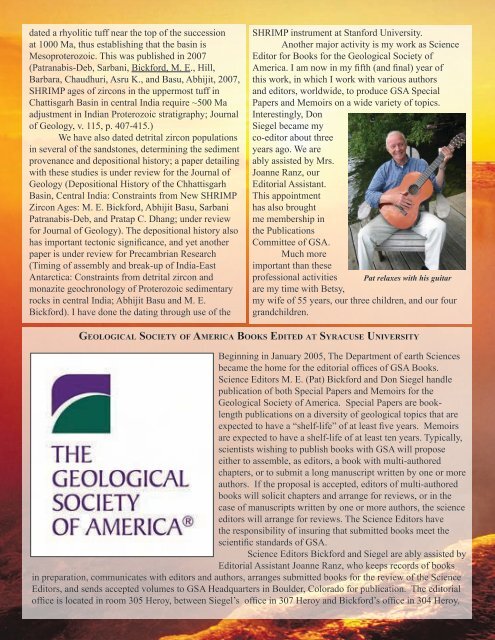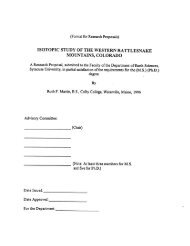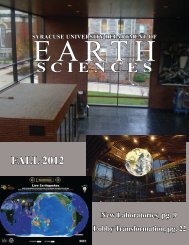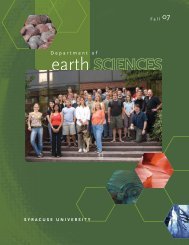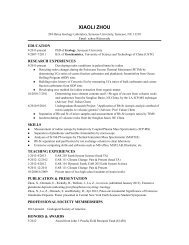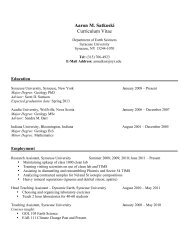alumni reception - Syracuse Universe Department of Earth Sciences ...
alumni reception - Syracuse Universe Department of Earth Sciences ...
alumni reception - Syracuse Universe Department of Earth Sciences ...
Create successful ePaper yourself
Turn your PDF publications into a flip-book with our unique Google optimized e-Paper software.
dated a rhyolitic tuff near the top <strong>of</strong> the succession<br />
at 1000 Ma, thus establishing that the basin is<br />
Mesoproterozoic. This was published in 2007<br />
(Patranabis-Deb, Sarbani, Bickford, M. E., Hill,<br />
Barbara, Chaudhuri, Asru K., and Basu, Abhijit, 2007,<br />
SHRIMP ages <strong>of</strong> zircons in the uppermost tuff in<br />
Chattisgarh Basin in central India require ~500 Ma<br />
adjustment in Indian Proterozoic stratigraphy; Journal<br />
<strong>of</strong> Geology, v. 115, p. 407-415.)<br />
We have also dated detrital zircon populations<br />
in several <strong>of</strong> the sandstones, determining the sediment<br />
provenance and depositional history; a paper detailing<br />
with these studies is under review for the Journal <strong>of</strong><br />
Geology (Depositional History <strong>of</strong> the Chhattisgarh<br />
Basin, Central India: Constraints from New SHRIMP<br />
Zircon Ages: M. E. Bickford, Abhijit Basu, Sarbani<br />
Patranabis-Deb, and Pratap C. Dhang; under review<br />
for Journal <strong>of</strong> Geology). The depositional history also<br />
has important tectonic significance, and yet another<br />
paper is under review for Precambrian Research<br />
(Timing <strong>of</strong> assembly and break-up <strong>of</strong> India-East<br />
Antarctica: Constraints from detrital zircon and<br />
monazite geochronology <strong>of</strong> Proterozoic sedimentary<br />
rocks in central India; Abhijit Basu and M. E.<br />
Bickford). I have done the dating through use <strong>of</strong> the<br />
SHRIMP instrument at Stanford University.<br />
Another major activity is my work as Science<br />
Editor for Books for the Geological Society <strong>of</strong><br />
America. I am now in my fifth (and final) year <strong>of</strong><br />
this work, in which I work with various authors<br />
and editors, worldwide, to produce GSA Special<br />
Papers and Memoirs on a wide variety <strong>of</strong> topics.<br />
Interestingly, Don<br />
Siegel became my<br />
co-editor about three<br />
years ago. We are<br />
ably assisted by Mrs.<br />
Joanne Ranz, our<br />
Editorial Assistant.<br />
This appointment<br />
has also brought<br />
me membership in<br />
the Publications<br />
Committee <strong>of</strong> GSA.<br />
Much more<br />
important than these<br />
pr<strong>of</strong>essional activities<br />
are my time with Betsy,<br />
Pat relaxes with his guitar<br />
my wife <strong>of</strong> 55 years, our three children, and our four<br />
grandchildren.<br />
Geological Society <strong>of</strong> America Books Edited at <strong>Syracuse</strong> University<br />
Beginning in January 2005, The <strong>Department</strong> <strong>of</strong> earth <strong>Sciences</strong><br />
became the home for the editorial <strong>of</strong>fices <strong>of</strong> GSA Books.<br />
Science Editors M. E. (Pat) Bickford and Don Siegel handle<br />
publication <strong>of</strong> both Special Papers and Memoirs for the<br />
Geological Society <strong>of</strong> America. Special Papers are booklength<br />
publications on a diversity <strong>of</strong> geological topics that are<br />
expected to have a “shelf-life” <strong>of</strong> at least five years. Memoirs<br />
are expected to have a shelf-life <strong>of</strong> at least ten years. Typically,<br />
scientists wishing to publish books with GSA will propose<br />
either to assemble, as editors, a book with multi-authored<br />
chapters, or to submit a long manuscript written by one or more<br />
authors. If the proposal is accepted, editors <strong>of</strong> multi-authored<br />
books will solicit chapters and arrange for reviews, or in the<br />
case <strong>of</strong> manuscripts written by one or more authors, the science<br />
editors will arrange for reviews. The Science Editors have<br />
the responsibility <strong>of</strong> insuring that submitted books meet the<br />
scientific standards <strong>of</strong> GSA.<br />
Science Editors Bickford and Siegel are ably assisted by<br />
Editorial Assistant Joanne Ranz, who keeps records <strong>of</strong> books<br />
in preparation, communicates with editors and authors, arranges submitted books for the review <strong>of</strong> the Science<br />
Editors, and sends accepted volumes to GSA Headquarters in Boulder, Colorado for publication. The editorial<br />
<strong>of</strong>fice is located in room 305 Heroy, between Siegel’s <strong>of</strong>fice in 307 Heroy and Bickford’s <strong>of</strong>fice in 304 Heroy.


